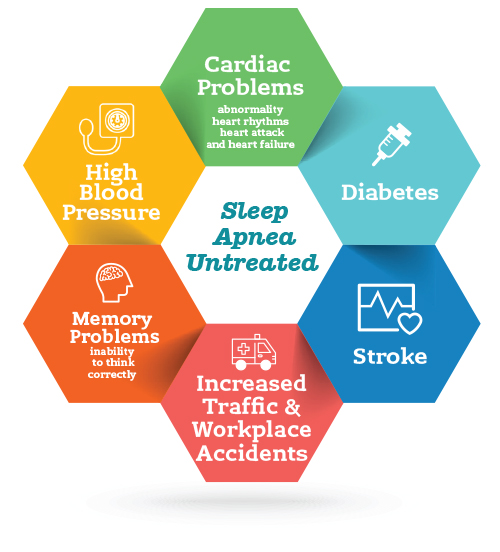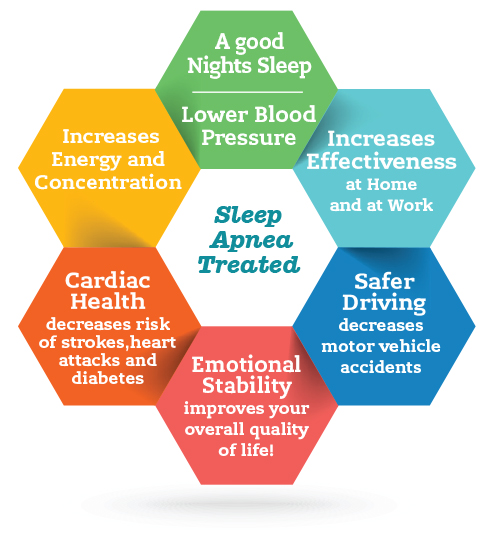


Snoring is often more than just annoying. It may be a symptom of a more serious sleep disorder called Obstructive Sleep Apnea. (OSA) However, not all people with sleep apnea snore.
Usually when you sleep, the muscles that control the upper airway relax; this is normal. However, if they relax too much, the airway narrows causing you to snore. The muscles can relax even further creating a blockage of the airway and you actually stop breathing. This is called “Obstructive Sleep Apnea”. Other factors can cause this as well. An enlarged uvula or swollen tonsils, a nasal obstruction or certain facial attributes can also cause OSA. Each episode can last ten seconds or more and has been known to happen hundreds of times a night; disrupting your sleep without you even being aware that it’s happening. Sleep apnea is often associated with excessive daytime sleepiness because your rest is regularly disturbed. However, you may not have symptoms and still have apnea.


Although Sleep Apnea is the most common sleep disorder, there are many other sleep disorders that can be diagnosed and treated at Rockland Sleep Center such as -
There are a variety of sleep disorders that are classified as a form of insomnia. This type of sleep disorder involves the inability to fall or stay asleep
Narcolepsy is usually described as excessive daytime sleepiness. It can begin at any age and continues through life. It is believed that there is a hereditary predisposition. The main symptoms include “sleep attacks” that can occur without warning and cataplexy, which is the sudden loss of voluntary muscle control.
Restless legs Syndrome is a neurological sleep disorder that make you have an overwhelming urge to move your legs. Restless legs syndrome makes it difficult to get comfortable enough to fall asleep. The symptoms are usually worse at night. The sensation is difficult for some people to describe. You may lie down and begin to feel burning or itching inside your legs. Restless legs syndrome may cause you to get fewer hours of sleep each night. Many people with severe cases get less than five hours of sleep per night. Milder cases do not disturb your sleep as much, though the sleep may be of poorer quality.
Central sleep apnea is a breathing disorder that causes your body to decrease or stop the effort of breathing during sleep. This occurs in an off-and-on cycle. It is a result of a problem in the brain or heart. It is different from obstructive sleep apnea (OSA) because the problem is not caused by a blockage of the airway.
Periodic limb movements are when you have episodes of simple, repetitive muscle movements. You are unable to control them. They usually do not keep you from falling asleep. Instead, they severely disrupt your sleep during the night. This can cause you to be very tired during the day. They occur typically in the lower limbs, about every 20-40 seconds. You may recognize these movements as brief muscle witches, jerking movements or an upward flexing of the feet.
REM sleep behavior disorder (RBD) is a parasomnia. A parasomnia involves undesired events that happen while sleeping. It occurs when you act out vivid dreams as you sleep. These dreams are often filled with action. They may even be violent. Episodes tend to get worse over time. Early episodes may involve mild activity and later episodes can be more violent. RBD is often ignored for years. An RBD episode often disrupts the sleep of a bed partner. This is how a person with RBD may become aware of the problem.
If you answered yes to one or more of these questions you may have a sleeping problem. While this questionnaire isn’t substitute for a professional diagnosis, it can help you determine whether or not to seek a professional opinion.

Rockland Sleep Center provides a safe and supportive environment. The sleep rooms are private with private bathrooms and showers. They are furnished with full size beds, recliners and cable television.
A qualified, registered sleep technologist will carefully set you up, explain the procedures and monitor you closely throughout the study. The monitoring equipment is painless and most people do not find it uncomfortable or an obstacle to falling asleep. While asleep, the technologist will monitor your brain wave actively, muscle activity, blood oxygen levels, airflow from your nose and mouth, and your chest and abdomen effort of breathing. After your testing is complete, a technologist will perform an analysis of your recording. The physician will then interpret your test.

Many patients can be effectively screened with one of our new home apnea monitoring systems. This is a simplified version of the in-lab study and focuses on nocturnal berating. These home monitoring devices are used only to diagnose or rule out obstructive sleep apnea. Home sleep screening is convenient and often covered by insurance.
A member of our sleep team will give you instruction on how to use the home sleep apnea test device. On the day of your test you can go to sleep at your regular bedtime. When you are ready to sleep you will attach the sensors to your body as instructed. You may be asked to keep a sleep log or to press a button on the machine whey you get into bed. When you wake up in the morning, you can remove the sensors. You may have to bring the device back to the sleep center or return it by mail.
Members of our sleep team will score and interpret the information collected through homes sleep apnea testing and contact you to discuss the results.
Call us today for more information and to find out if a home study is right for you.
CPAP is the Gold Standard for treatment of Obstructive Sleep Apnea. It works by gently blowing air into the nose and/or mouth, creating positive pressure and holding the tissue in the neck and throat.
Although CPAP is the most common and reliable method of treating sleep apnea, some people find it cumbersome or uncomfortable and give up on CPAP. However with some practice most people learn to adjust the tension of the mask straps to obtain a comfortable and secure fit.
Patients may need to try more than one type of mask to find one that’s comfortable. Some patients also benefit from using a humidifier along with their CPAP machines. Patients are advised to not stop using the CPAP machine if they experience problems. Instead, Please call us to see what changes can be made to make them more comfortable. The doctor should also be informed if snoring continues or stops and then resumes—or if the patient’s weight changes. In that situation, the pressure settings on the CPAP machine may need to be adjusted.
Oral appliances are another option. These are removable devices, typically provided by a dentist, that move the jaw forward, hold the tongue in a different position, or otherwise help keep the throat open during sleep and possibly relieve snoring and obstructive sleep apnea. These devices are generally most successful with mild cases of sleep apnea. Rocklands Sleep Center works with many excellent dentists trained in the treatment of sleep apnea and can refer you for a consult.
Surgery is usually only an option after other treatments have failed. The goal of surgery for sleep apnea is to enlarge the airway through the nose or throat that may be vibrating and causing the patient to snore or which may be blocking the upper air passages and causing sleep apnea. There are multiple surgeries that can be considered for your sleep apnea. Our board certified doctors will discuss your treatment options and refer you for an appropriate consultation.
There are a variety of lifestyle changes that you can make to help you reduce your snoring and improve your sleep apnea symptoms.
Lose weight – surprisingly, formal studies indicate that effective weight loss may lead to lesser, lighter snoring and diminished incidents of apnea during sleep. In addition practitioners report striking improvements in both sleep apnea and snoring among patients who lose weight.
Sleep on one side. Most forms of sleep apnea are milder when the person sleeps on one side. Sleeping on the back can cause the tongue and soft palate to rest against the back of the throat and block the airway. To prevent sleeping on the back, try sewing a tennis ball into the back of the pajama top.
Avoid alcohol as well as tranquilizers and other such sedative medications. Both alcohol and drugs relax the back of the throat, interfering with breathing.
Avoid driving if drowsy. Sleep apnea can make the patient abnormally sleepy, creating higher risk of motor vehicle accidents. If a friend or family member tells the patient that he or she appears sleepier than they may feel, they should try to avoid driving.
Quit smoking. Smoking worsens obstructive sleep apnea.